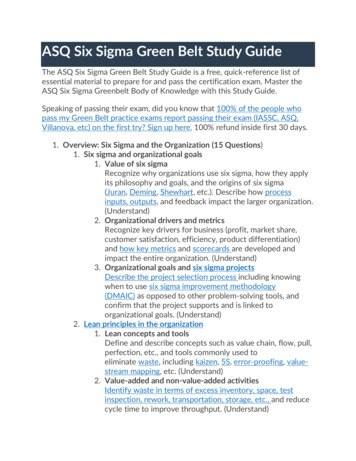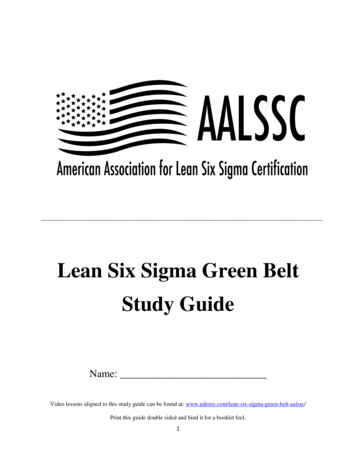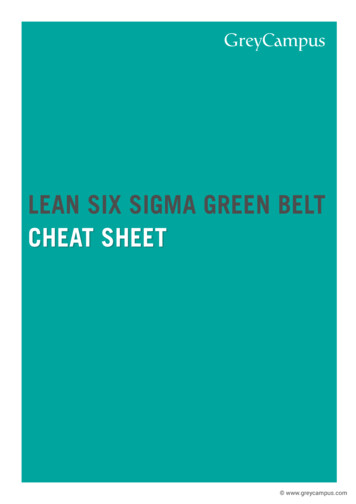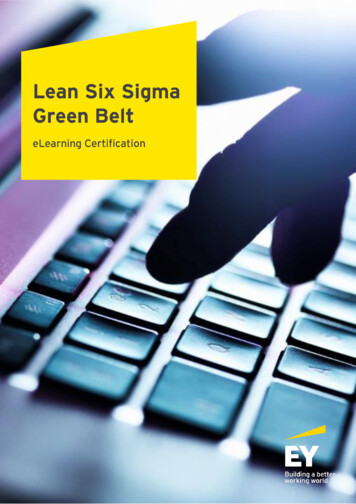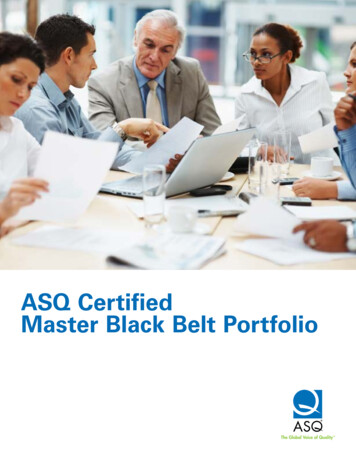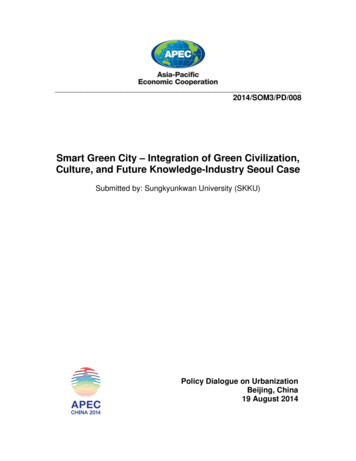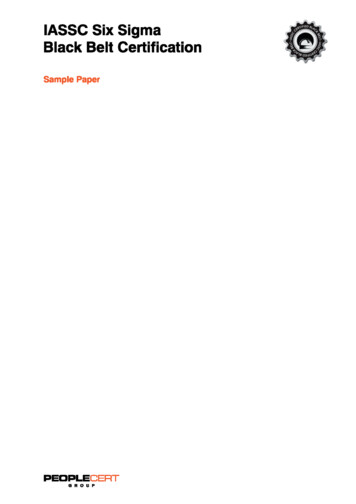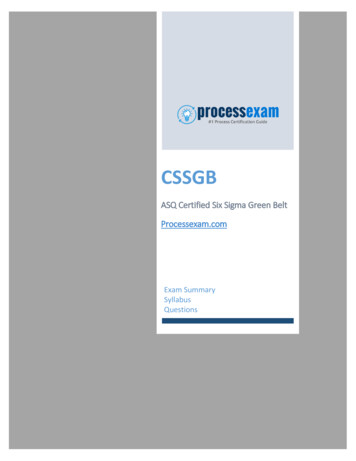
Transcription
CSSGBASQ Certified Six Sigma Green BeltProcessexam.comExam SummarySyllabusQuestions
CSSGB Sample Questions and Exam SummaryTable of ContentsKey to success in CSSGB Exam on ASQ Certified Six Sigma Green Belt. 2ASQ CSSGB Certification Details: . 2ASQ CSSGB Exam Syllabus: . 3I. Overview: Six Sigma and the Organization (13 Questions) . 3II. Define Phase (23 Questions) . 4III. Measure Phase (23 Questions) . 6IV. Analyze Phase (15 Questions) . 8V. Improve Phase (15 Questions). 8VI Control Phase (11 Questions) . 9CSSGB Sample Questions: . 9Answers to CSSGB Exam Questions: . 11CSSGB- ASQ Certified Six Sigma Green Beltpg. 1
CSSGB Sample Questions and Exam SummaryKey to success in CSSGB Exam on ASQ Certified Six SigmaGreen BeltTo achieve the professional designation of Certified Six Sigma Green Belt from the ASQ,candidates must clear the CSSGB Exam with the minimum cut-off score. For those whowish to pass the ASQ CSSGB certification exam with good percentage, please take a lookat the following reference document detailing what should be included in ASQ Six SigmaGreen Belt Exam preparation.The ASQ CSSGB Exam Summary, Body of Knowledge (BOK), Sample Question Bank andPractice Exam provide the basis for the real ASQ Certified Six Sigma Green Belt exam.We have designed these resources to help you get ready to take Certified Six SigmaGreen Belt (CSSGB) exam. If you have made the decision to become a certifiedprofessional, we suggest you take authorized training and prepare with our onlinepremium ASQ Six Sigma Green Belt Practice Exam to achieve the best result.ASQ CSSGB Certification Details:Exam NameCertified Six Sigma Green BeltExam CodeCSSGBExam FeeUSD 438RetakesUSD 238ASQ MemberUSD 288Application FeeUSD 70Exam Duration270 MinutesNumber ofQuestions110Passing Score550/750FormatMultiple ChoiceBooksCertified Six Sigma Green Belt Certification PreparationThe Certified Six Sigma Green Belt Handbook, Second EditionSchedule ExamBook Your ExamSample Questions ASQ CSSGB Exam Sample Questions and AnswersPractice ExamASQ Certified Six Sigma Green Belt Practice TestCSSGB- ASQ Certified Six Sigma Green Beltpg. 2
CSSGB Sample Questions and Exam SummaryASQ CSSGB Exam Syllabus:I. Overview: Six Sigma and the Organization (13Questions)1. Value of Six Sigma- Recognize why organizations use Six Sigma, how they apply itsphilosophy and goals, and the evolution of Six Sigma fromquality leaders such as Juran, Deming, Shewhart, Ishikawa, andothers. (Understand)2. Organizational goals and Six Sigma projects- Identify the linkages and supports that need to be establishedA. Six Sigma and between a selected Six Sigma project and the organization’sOrganizationalgoals, and describe how process inputs, outputs, and feedbackat all levels can influence the organization as a whole.Goals(Understand)3. Organizational drivers and metrics- Recognize key business drivers (profit, market share, customersatisfaction, efficiency, product differentiation) for all types oforganizations. Understand how key metrics and scorecards aredeveloped and how they impact the entire organization.(Understand)1. Lean concepts- Define and describe lean concepts such as theory ofconstraints, value chain, flow, and perfection. (Apply)B. Lean Principles2. Value stream mappingin the- Use value stream mapping to identify value-added processesOrganizationand steps or processes that produce waste, including excessinventory, unused space, test inspection, rework, transportation,and storage. (Understand)1. Road maps for DfSS- Distinguish between DMADV (define, measure, analyze, design,verify) and IDOV (identify, design, optimize, verify), andrecognize how they align with DMAIC. Describe how theseC. Design for Six methodologies are used for improving the end product orSigma (DfSS)process during the design (DfSS) phase. (Understand)Methodologies2. Basic failure mode and effects analysis (FMEA)- Use FMEA to evaluate a process or product and determine whatmight cause it to fail and the effects that failure could have.Identify and use scale criteria, calculate the risk priority number(RPN), and analyze the results. (Analyze)CSSGB- ASQ Certified Six Sigma Green Beltpg. 3
CSSGB Sample Questions and Exam Summary3. Design FMEA and process FMEA- Define and distinguish between these two uses of FMEA.(Apply)II. Define Phase (23 Questions)A. ProjectIdentification1. Project selection- Describe the project selection process and what factors shouldbe considered in deciding whether to use the Six Sigma DMAICmethodology or another problemsolving process. (Understand)2. Process elements- Define and describe process components and boundaries.Recognize how processes cross various functional areas and thechallenges that result for process improvement efforts. (Analyze)3. Benchmarking- Understand various types of benchmarking, includingcompetitive, collaborative, and best practices. (Understand)4. Process inputs and outputs- Identify process input and output variables and evaluate theirrelationships using the supplier, input, process, output, customer(SIPOC) model. (Analyze)5. Owners and stakeholders- Identify the process owners and other stakeholders in aproject. (Apply)B. Voice of theCustomer (VoC)1. Customer identification- Identify the internal and external customers of a project, andwhat effect the project will have on them. (Apply)2. Customer data- Collect feedback from customers using surveys, focus groups,interviews, and various forms of observation. Identify the keyelements that make these tools effective. Review data collectionquestions to eliminate vagueness, ambiguity, and anyunintended bias. (Apply)3. Customer requirements- Use quality function deployment (QFD) to translate customerrequirements statements into product features, performancemeasures, or opportunities for improvement. Use weightingmethods as needed to amplify the importance and urgency ofdifferent kinds of input; telephone call vs. survey response;product complaint vs. expedited service request. (Apply)CSSGB- ASQ Certified Six Sigma Green Beltpg. 4
CSSGB Sample Questions and Exam Summary1. Project charter- Define and describe elements of a project charter and developa problem statement that includes baseline data or currentstatus to be improved and the project’s goals. (Apply)2. Project scope- Help define the scope of the project using process maps,Pareto charts, and other quality tools. (Apply)3. Project metrics- Help develop primary metrics (reduce defect levels by xamount) and consequential metrics (the negative effects thatmaking the planned improvement might cause). (Apply)4. Project planning tools- Use Gantt charts, critical path method (CPM), and programevaluation and review technique (PERT) charts to plan projectsand monitor their progress. (Apply)C. Project5. Project documentationManagement- Describe the types of data and input needed to document aBasicsproject. Identify and help develop appropriate presentation tools(storyboards, spreadsheet summary of results) for phasereviews and management updates. (Apply)6. Project risk analysis- Describe the elements of a project risk analysis, includingfeasibility, potential impact, and risk priority number (RPN).Identify the potential effect risk can have on project goals andschedule, resources (materials and personnel), costs and otherfinancial measures, and stakeholders. (Understand)7. Project closure- Review with team members and sponsors the projectobjectives achieved in relation to the charter and ensure thatdocumentation is completed and stored appropriately. Identifylessons learned and inform other parts of the organization aboutopportunities for improvement. (Apply)D. Managementand PlanningToolsDefine, select, and apply these tools:1) affinity diagrams,2) interrelationship digraphs,3) tree diagrams,4) prioritization matrices,5) matrix diagrams,6) process decision program charts (PDPC), and7) activity network diagrams. (Apply)CSSGB- ASQ Certified Six Sigma Green Beltpg. 5
CSSGB Sample Questions and Exam Summary1. Process performance- Calculate process performance metrics such as defects per unit(DPU), rolled throughput yield (RTY), cost of poor qualityE. Business(CoPQ), defects per million opportunities (DPMO), sigma levels,Results forand process capability indices. Track process performancemeasures to drive project decisions. (Analyze)Projects2. Communication- Define and describe communication techniques used inorganizations: top-down, bottom-up, and horizontal. (Apply)F. TeamDynamics andPerformance1. Team stages and dynamics- Define and describe the stages of team evolution, includingforming, storming, norming, performing, adjourning, andrecognition. Identify and help resolve negative dynamics such asoverbearing, dominant, or reluctant participants, theunquestioned acceptance of opinions as facts, groupthink,feuding, floundering, the rush to accomplishment, attribution,discounts, digressions, and tangents. (Understand)2. Team roles and responsibilities- Describe and define the roles and responsibilities ofparticipants on Six Sigma and other teams, including Black Belt,Master Black Belt, Green Belt, champion, executive, coach,facilitator, team member, sponsor, and process owner. (Apply)3. Team tools- Define and apply team tools such as brainstorming, nominalgroup technique, and multivoting. (Apply)4. Team Communication- Identify and use appropriate communication methods (bothwithin the team and from the team to various stakeholders) toreport progress, conduct reviews, and support the overallsuccess of the project. (Apply)III. Measure Phase (23 Questions)A. ProcessAnalysis andDocumentation- Develop process maps and review written procedures, workinstructions, and flowcharts to identify any gaps or areas of theprocess that are misaligned. (Create)1. Basic probability concepts- Identify and use basic probability concepts: independentB. Probability and events, mutually exclusive events, multiplication rules,Statisticspermutations, and combinations. (Apply)2. Central limit theorem- Define the central limit theorem and describe its significance inCSSGB- ASQ Certified Six Sigma Green Beltpg. 6
CSSGB Sample Questions and Exam Summaryrelation to confidence intervals, hypothesis testing, and controlcharts. (Understand)C. StatisticalDistributions- Define and describe various distributions as they apply tostatistical process control and probability: normal, binomial,Poisson, chi square, Student’s t, and F. (Understand)1. Types of data and measurement scales- Identify and classify continuous (variables) and discrete(attributes) data. Describe and define nominal, ordinal, interval,and ratio measurement scales. (Analyze)2. Sampling and data collection methods- Define and apply various sampling methods (random andstratified) and data collection methods (check sheets and dataD. Collecting and coding). (Apply)Summarizing3. Descriptive statistics- Define, calculate, and interpret measures of dispersion andDatacentral tendency. Develop and interpret frequency distributionsand cumulative frequency distributions. (Evaluate)4. Graphical methods- Construct and interpret diagrams and charts that are designedto communicate numerical analysis efficiently, including scatterdiagrams, normal probability plots, histograms, stem-and-leafplots, box-and-whisker plots. (Create)- Calculate, analyze, and interpret measurement systemE. Measurementcapability using gauge repeatability and reproducibility (GR&R)System Analysisstudies, measurement correlation, bias, linearity, percent(MSA)agreement, and precision/tolerance (P/T). (Evaluate)F. Process andPerformanceCapability1. Process performance vs. process specifications- Define and distinguish between natural process limits andspecification limits, and calculate process performance metrics.(Evaluate)2. Process capability studies- Define, describe, and conduct process capability studies,including identifying characteristics, specifications, andtolerances, and verifying stability and normality. (Evaluate)3. Process capability (Cp, Cpk) and process performance (Pp,Ppk) indices- Describe the relationship between these types of indices.Define, select, and calculate process capability and processperformance. Describe when Cpm measures can be used.Calculate the sigma level of a process. (Evaluate)4. Short-term vs. long-term capability and sigma shiftCSSGB- ASQ Certified Six Sigma Green Beltpg. 7
CSSGB Sample Questions and Exam Summary- Describe the assumptions and conventions that are appropriateto use when only short-term data are used. Identify andcalculate the sigma shift that occurs when longand short-termdata are compared. (Evaluate)IV. Analyze Phase (15 Questions)A. ExploratoryData Analysis1. Multi-vari studies- Select appropriate sampling plans to create multi-vari studycharts and interpret the results for positional, cyclical, andtemporal variation. (Create)2. Correlation and linear regression- Describe the difference between correlation and causation.Calculate the correlation coefficient and linear regression andinterpret the results in terms of statistical significance (p-value).Use regression models for estimation and prediction. (Evaluate)B. HypothesisTesting1. Basics- Distinguish between statistical and practical significance.Determine appropriate sample sizes and develop tests forsignificance level, power, and type I and type
premium ASQ Six Sigma Green Belt Practice Exam to achieve the best result. ASQ CSSGB Certification Details: Exam Name Certified Six Sigma Green Belt Exam Code CSSGB Exam Fee USD 438 Retakes USD 238 ASQ Member USD 288 Application Fee USD 70 Exam Duration 270 Minutes Number of Questions 110 Passing Score 550/750 Format Multiple Choice Books Certified Six Sigma Green Belt

